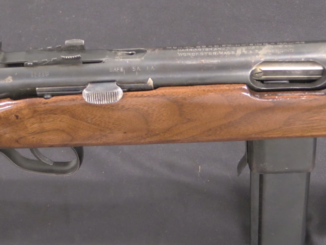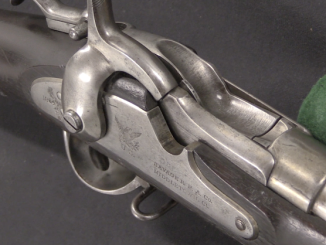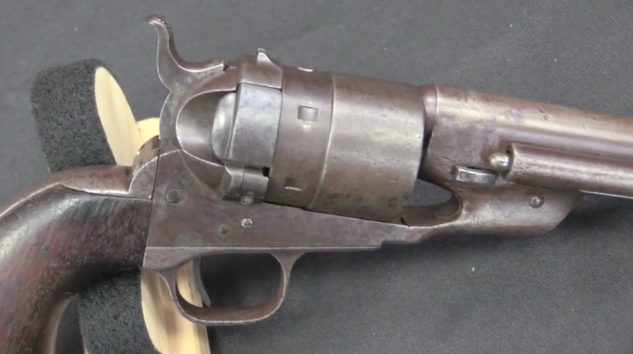The Evans rifle/carbine was developed in 1873 by a Maine dentist named Warren Evans. Its main innovation was a large helical magazine that held a whopping 34 cartridges of Evan’s proprietary .44 caliber cartridge. By 1877 Evans had made a number of revisions and improvements to the gun, including developing a newer and more powerful cartridge for it. This New Model “only” held 28 rounds, but was ballistically very similar to the .56 Spencer.
Evans’ rifle was a lever action design, and proved reasonably popular. Between 12,000 and 15,000 were made in total between 1874 and 1879, and testimonials were published from the likes of Kit Carson and Buffalo Bill Cody. The US Army tested the weapon but rejected it on the basis of its awkward loading procedure and failure of a dust test. Sales were made outside the US, though, including Russia, Turkey, and several South American nations.




“proprietary .44 caliber cartridge”
http://www.municion.org/Evans/44Short.htm
“newer and more powerful cartridge”
http://www.municion.org/Evans/44LongNewModel.htm
To this day, I cannot see an Evans or read about one without picturing a downright hilarious scene from the film “Crossfire Trail”…
“Why do you shoot that old Evans, Joe?”
“Well, it has twenty-eight rounds, and I ain’t a very good shot.”
It’s nice to know some of the technical details were at least correct, with regards to the 28 round capacity.
According to the organic lines seeming octopus, rifle looks like as come from lost city of Atlantis.
Glad I’m not the only one to see that.
To me, it’s always looked like a sort of “hammerless” Spencer. But I see what you mean.
😉
cheers
eon
Hello, Ian: I’m mailing some information on Evans cartridges, moulds and bullets. It was a flat-base bullet.
Dear Ian ,
Just being curious I watched your previous video of The Evans and followed the link with it. This led to a whole series of photos of a rebuilding interestingly enough there are a couple of shots of a pulled bullet and cartridge showing, as you suggested, a large hollow base which would expand to f it the rifling when fired. Great video thanks.
The Mannlicher Model 1880 bolt-action repeating rifle had a very similar magazine setup. Called a “tube sheaf” magazine, it had three tubes with a spring and follower in each one, each tube holding five 11.15 x 58Rmm Werndl M1877 centerfire cartridges.
Operating the bolt also operated a slide under the front of the magazine which turned it by a cam path machined into the front part of the rotating magazine assembly. This cam turned it 120 degrees so a tube could feed a fresh cartridge up to the boltway. It fed from each tube in turn, rather than emptying one and then changing to the next.
Reloading it was done by opening the bolt and feeding rounds backward into each tube one at a time until full, then rotating it one-third of a turn and doing the next one. So it was as least as tedious to reload as the Evans.
There was also an experimental version in 11.15 x 60Rmm Mauser for Prussia, that had four tubes each holding five rounds. It would have been even more fun to reload under fire, I imagine.
A magazine cutoff was provided, and I’m sure it would have been used most of the time if the thing had ever reached service status. Which it didn’t.
The only way to make either of these, the Evans or the Mannlicher, practical would have been to have detachable, slide-in magazine assemblies that could be carried preloaded and inserted like a modern box magazine.
Something like the Blakeslee carrier for “speedloader” tubes for the Spencer would have been needed to carry them, because I suspect they would have been a bit on the delicate side.
You certainly wouldn’t want to dent one.
cheers
eon
With all that in mind, I’d rather take the often overlooked Hanyang 88 rifle, even if production quality was considered not so great. At least the magazine and en-bloc clip system worked, considering that the Hanyang was a copy of the 1888 Commission Rifle. And unlike the German predecessor, the Hanyang didn’t have a ridiculously heavy barrel shroud.
This is such an oddball design that it’s somewhat surprising that it even [reliably] worked at all (no doubt a removable magazine would have been a huge improvement). It would seem that large capacity helical magazines like this could generate a great deal of internal friction –and therefore jam easily– unless the cartridges were heavily greased.
We can probably easily guess the result of “mud test”.
Kit Carson died of an aortic aneurysm on May 23, 1868 at Fort Lyon, Colorado and was presumably not available for comment in 1873 when the gun was developed. Sorry about that, Chief!
I think it was developed earlier than 1973, Russian sources say they tested musket length model in 1967…
Patents:
For the helical magazine:
http://www.google.com/patents/US84685
Original patent for the lock:
http://www.google.com/patents/US119020
Reissued patent that looks more like the gun as built (first model):
http://www.google.com/patents/USRE7635
As to the why of the bore diameter vs. the diameter of bullets in these cartridges. My guess is that this gun was originally designed to use outside lubricated bullets of the heeled type, (think standard .22 Long Rifle). Looking at the various chamber casts online, they all look just like many of the rifles I’ve done castings of that were originally chambered for outside lubricated, heeled bullets, with just enough of the lands machined away to fit the case into the barrel.
Now, this old outside lubricated ammunition was a real greasy mess to handle, with many of them having their bullets stuck together in one big blob of grease in the box. This lubricating grease got into and onto everything and is sure to have fouled up that nifty helical cartridge feeding mechanism, especially if the magazine was fully loaded and left out in the sun.
So, inside lubrication is a must to prevent gumming up the works, but the bullet has to be small enough so all of it fits into the case. And that’s how you end up with undersized bullets. You will find this situation in many guns made during this transitional period between outside and inside lubricated bullets.
Luckily, if you make your bullets from soft, pure lead, and drive them with a sufficient amount of black powder, the base of the bullet will deform to fill the grooves of the barrel and not foul-out the gun with leading caused by the hot flaming gasses rushing past the bullet when it first pops out of the case. ^__^
The ideal solution for the modern user is to get a custom heeled bullet made that fits both the case and the bore and lubricate it with a modern, not so messy bullet lubricant.